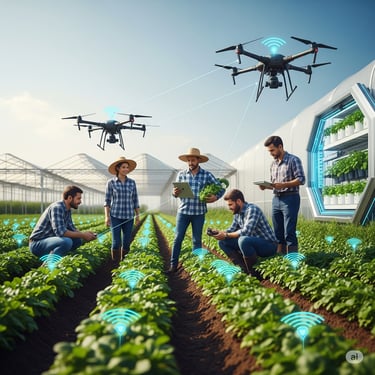The Smart Farm & The Future Synergy - Cultivating Efficiency and Collaboration
In the first two articles of this series, we've explored agriculture's surprising role as a major energy consumer and its emerging potential as a producer of green power. We've seen the significant energy drain imposed by the global food systems and the promise of bioenergy and agrivoltaics. Yet, the journey towards comprehensive sustainability isn't just about where the energy comes from; it's about how it is used.
AGRICULTURE AND ENERGY
Aadesh Aslekar
7/13/20254 min read


The ultimate vision for sustainable agriculture requires efficiency and intelligence. The largest gains in the energy-food nexus may not come from generating more power but by optimizing and reducing demand across the supply chain. This is where "Smart Farm" intersects with the future of the energy industry, driven by regenerative agricultural practices and digital innovations.
The Era of Precision Agriculture: Farming Smarter, Not Harder
Precision agriculture has emerged as a game-changer in the field of agriculture. This technology-driven approach involves the use of remote sensing, geographic information systems (GIS), and global positioning systems (GPS) to analyse and manage variability in crops. By collecting real-time data on soil conditions, moisture levels, and crop health, farmers can make informed decisions regarding irrigation, fertilization, and pest control. This not only reduces resource wastage but also enhances crop yields and minimizes environmental impact.
Optimizing Water Use - Irrigation, as we noted in part 1, is a massive consumer of electricity and fuel for pumping. Sensors and data analytics help monitor soil moisture levels and weather conditions, allowing for precise adjustments to irrigation schedules and amounts. By delivering water only when and where it's needed, precision irrigation can significantly reduce water usage compared to traditional methods.
Integrated Nutrient Management - Synthetic fertilizer, particularly nitrogen, carries a massive energy footprint. Precision farming enhances food quality and reduces fertilizer usage by utilizing soil sensors to analyze nutrient levels and GPS technology to map field variability. It also helps minimize over-fertilization, which can lead to nutrient runoff and environmental pollution. Combining organic and chemical fertilizers, along with other nutrient sources, further optimizes nutrient use and reduces reliance on synthetic fertilizers, directly cutting the embodied energy consumption.
Digitalized Operations - The use of AI to optimize machinery routes, minimize overlap in field operations, and predict planting and harvesting schedules reduces fuel consumption and minimizes operational downtime.
Electrification and The Circular Economy
Beyond digital optimization, the physical infrastructure of farming is undergoing a transformation aimed at reducing the reliance on fossil fuels.
Electrified farming practices are progressively recognized as a more sustainable alternative to conventional fossil fuel-dependent methods. It not only contributes to the reduction of greenhouse gas emissions but also decreases reliance on non-renewable energy sources. Over time, electric-powered equipment can prove to be more cost-effective due to lower operating and maintenance expenses. Governments worldwide are facilitating this transition through incentives and subsidies, encouraging the adoption of electric machinery in agriculture.
Circular Economy - The concept of a circular economy in farming mimics natural ecosystems by focusing on sustainability. This approach reduces the environmental footprint while enhancing the efficiency and resilience of agriculture.
Circular economy in farming refers to an agricultural system that:
Is designed to minimize waste throughout the entire production process.
Keeps products and materials in use, maximizes the value of resources, and reduces the continuous demand for new inputs.
Regenerates natural systems, enhancing ecosystem services, promoting biodiversity, soil health, and efficient water use.
Case Study: Circular Farming at Nandi Foundation, India
The Nandi Foundation, based in India, is a non-profit organization that promotes sustainable farming practices. Through its "Araku Coffee Project," it has implemented circular economy principles, helping small-scale farmers in the Araku Valley adopt eco-friendly methods. The project focuses on organic coffee cultivation, improving soil health, and ensuring a sustainable livelihood for farmers.
The Imperative for Collaboration: Bridging Silos
Achieving an energy-efficient agricultural future requires more than just technological advancements; it demands unprecedented collaboration. The transition of agricultural energy footprints cannot be driven by professionals, technological developers, academics, and policymakers.
Government Incentives:
Governments worldwide are implementing policies and providing incentives to encourage the adoption of renewable energy technologies in agriculture.
Research and Development:
Investing in research to develop new technologies and sustainable farming practices, including energy storage solutions and more efficient renewable energy systems.
Public-Private Partnerships:
Collaboration between governments, research institutions, and private companies is crucial for scaling up renewable energy solutions in agriculture.
Knowledge Sharing:
Promoting the exchange of information and best practices among farmers, researchers, and policymakers to accelerate the transition to sustainable agriculture.
The synergy between these sectors - the flow of insights and capital from energy technology into agricultural practice - is the engine of this future. By integrating energy management expertise with agricultural knowledge, we can unlock efficiencies and systems that are both resilient and sustainable.
The journey through the energy-food nexus reveals a fundamental truth: the future of energy security and the future of food security are inextricably linked.
We began by acknowledging agriculture as an often invisible but major energy consumer. We then explored its capacity to produce clean power, turning fields into viable solar arrays and waste into valuable bioenergy. Finally, we have seen how digital transformation and precision agriculture are poised to revolutionize efficiency, dramatically reducing the energy demand of farming.
The transition to a truly sustainable global system requires us to view agriculture not as a separate entity but as an integral component of the energy system. By cultivating efficiency, embracing innovative energy technologies, and fostering rigorous collaboration between diverse sectors, we can move beyond simply sustaining our current systems. We can cultivate a future that is not only food-secure but also energy-abundant and resilient.
The field is ripe for innovation. By bridging the silos between the energy and agricultural industries, we can collectively unlock the potential of the Smart Farm- A cornerstone of a truly sustainable future.
References
Advancements in Agricultural Engineering: Revolutionizing the Fut
Emerging Agricultural Engineering Sciences, Technologies, and Applications
Precision Farming Market Size, Share, Trends and Growth Analysis 2032
Conserving Water with Smart Irrigation and Precision Farming Solutions | Food Logistics
Circular Economy in Farming: A Sustainable Approach
Regenerative agriculture can help feed the world. What is it? | World Economic Forum
3 unusual ways renewable energy is giving farming a boost | World Economic Forum
Nanofertilizers for Sustainable Crop Production: A Comprehensive Review | BioNanoScience
Agriculture as energy producer | EBSCO Research Starters
Agriculture as Energy Prosumer: Review of Problems, Challenges, and Opportunities
https://link.springer.com/article/10.1007/s13593-020-00627-2
Connect
info@energizetomorrowus.com
© 2025. All rights reserved.


